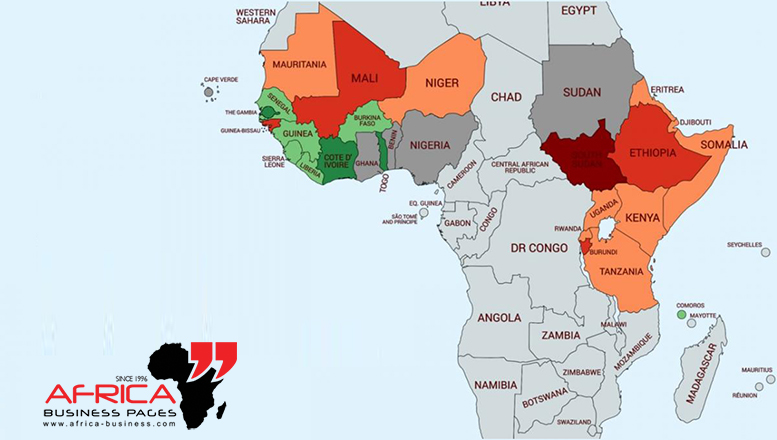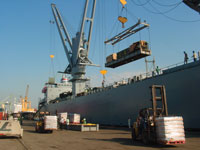Evergrow International
Gifts, Novelties and Promotional Material supplier. Watches, Bags, Key Chains, Desktop accessories, Pen Sets, Gift Items... Wanted business partners in Africa...

East and West Africa may be on the same continent, just five hours flight from each other, and with complementary economies that would make it natural enough for a high level of interaction. But, in reality, they are virtually cut off from one another.
With a combined population of two-fifths of a billion, and well-matched  resources, East and West Africa have some of
the lowest trade between them of any regions in the world, according to a UN report,
with just one carrier running costly and often half-empty flights between the regions,
no road route, and negligible traffic between the two continental hubs. To fly to West
Africa from East Africa costs twice or thrice as much as flying from Africa to Europe,
including to London, which is eight and half hours away. As an example, flying to Dakar
on economy and business costs $1,281 and $4,076 on Kenya Airways and is possible on
three flights a week. Yet a return ticket to London, with many departures a day, costs
from $668 on Virgin Atlantic. Yet Kenya Airways, which operates around five flights a
week to West Africa, remains the only carrier covering the route with direct flights,
and often the flights, which together could transport only around 1,000 to 2,000 people
a week, are not full.
resources, East and West Africa have some of
the lowest trade between them of any regions in the world, according to a UN report,
with just one carrier running costly and often half-empty flights between the regions,
no road route, and negligible traffic between the two continental hubs. To fly to West
Africa from East Africa costs twice or thrice as much as flying from Africa to Europe,
including to London, which is eight and half hours away. As an example, flying to Dakar
on economy and business costs $1,281 and $4,076 on Kenya Airways and is possible on
three flights a week. Yet a return ticket to London, with many departures a day, costs
from $668 on Virgin Atlantic. Yet Kenya Airways, which operates around five flights a
week to West Africa, remains the only carrier covering the route with direct flights,
and often the flights, which together could transport only around 1,000 to 2,000 people
a week, are not full.
Communication is not better. Telephone charges between African countries can be 50 to 100 times higher than within Northern America, according to a World Bank report, acting as a hindrance to even basic conversation. Moreover, the weak air links are compounded by the absence of any direct links by road, rail or sea. The road network is anyway a big challenge inside the two regions, let alone between them. A recent study by West Africa Trade Hub (WATH), an Accra-based institution, showed that the cost of transporting a container by road from Accra to Lagos, costs three times as much as transporting the same container from the United Kingdom to Lagos. Added to that, Dr Joshua Kivuva, a lecturer in the department of political science, University of Nairobi, says relations between East and West Africa have been historically limited. “Different languages could also be attributed to the minimum contact between the two regions,” he adds.
 A UN Economic Commission report
showed trade among African countries accounts for about 10 per cent of their total
external trade, the lowest in any world region, while trade with Europe accounts for
approximately 40 per cent of exports. Regional economic communities have facilitated
trade and investment between African countries by reducing trade barriers, bringing
tangible benefits in employment and incomes. And the low trade levels between East and
West Africa is replicated across other African regions. Because of hindrances to trade
within Africa, exports from Tunisia and Cameroon often find their way to French
warehouses before being redirected to each other’s market.
A UN Economic Commission report
showed trade among African countries accounts for about 10 per cent of their total
external trade, the lowest in any world region, while trade with Europe accounts for
approximately 40 per cent of exports. Regional economic communities have facilitated
trade and investment between African countries by reducing trade barriers, bringing
tangible benefits in employment and incomes. And the low trade levels between East and
West Africa is replicated across other African regions. Because of hindrances to trade
within Africa, exports from Tunisia and Cameroon often find their way to French
warehouses before being redirected to each other’s market.
Yet while both East and West Africa’s economic drivers are agriculture, oil and mineral resources, these are more scarce in East Africa than in West and could be a source of vibrant trade between the two territories. Likewise, East Africa is moving at a different pace than the West as knowledge economies. Figures from the Export Promotion Council show low levels of trade between East Africa and West Africa, compared to East Africa and other parts of the continent. In 2009, Kenya imported goods worth Sh9.6 billion from Egypt, while it exported Sh12 billion worth of goods to the North African nation.
In comparison, Kenya bought products worth Sh109 million from Nigeria, and exported Sh1.2 billion of mainly agricultural products to the country. The fact that Kenya and Egypt belong to the Comesa trading block has significantly contributed to the high volume of trade between the two countries. With 19 member states and a combined population of 430 million people, COMESA’s annual export bill of US$ 157 billion makes it one of the giant regional trade bodies in Africa.
Meanwhile, 26 countries in northern, east, and southern Africa, are on  course to forming one free trading
block as was agreed in the first summit held in Uganda in 2007. The member countries of
the three regional trading blocs — EAC, Comesa and SADC — are currently harmonising
rules of engagement, ahead of the 2012 deadline when the trade area is to start
operating. “This is aimed at deepening trade between these countries. Formation of the
free trade area is also in line with AU’s (Africa Union) vision of having an African
economic community,” says Richard Sindiga, head of Comesa desk in the Ministry of Trade.
course to forming one free trading
block as was agreed in the first summit held in Uganda in 2007. The member countries of
the three regional trading blocs — EAC, Comesa and SADC — are currently harmonising
rules of engagement, ahead of the 2012 deadline when the trade area is to start
operating. “This is aimed at deepening trade between these countries. Formation of the
free trade area is also in line with AU’s (Africa Union) vision of having an African
economic community,” says Richard Sindiga, head of Comesa desk in the Ministry of Trade.
With West Africa effectively outside this new bloc, and hard to reach from the rest of Africa by road, rail, air and phone, East and West additionally remain largely offline on the world wide web. In Sub Saharan Africa, Internet penetration is below seven per cent, while in Northern Africa its approximately 32 per cent as per recently releases AEO figures. This disparity continues to present a real obstacle in information sharing and referencing between African countries, meaning that, for instance, when epidemics occur, tolls are higher than in Western countries. And there remains a huge disparity between those in the population that can access information and those that can’t.
On the East/West axis, the number of Nigerian Internet users is now over eight million, compared with Kenya’s three million users. Yet the West African numbers are low per population, as Nigeria has nearly 150 million people, while Kenya has some 40 million people. For now, the world may be a global village, but East and West Africa are barely even talking to each other.
Previous NextGifts, Novelties and Promotional Material supplier. Watches, Bags, Key Chains, Desktop accessories, Pen Sets, Gift Items... Wanted business partners in Africa...
Competitively priced tyres of almost all well known brands like Advance, Double Happiness, GT, Double Ox, Hankook etc. BBG Trading is a major exporter to African markets...
Manufacturer of high quality range of cosmetics – including haircare, skincare, nail care products. The company seeks buyers of cosmetics in Africa. Agents and distributors wanted in African...
An established export and distribution company based out of Hong Kong and China since 1990. The company specializes in the trade of dry-break bulk agro-commodities...
An established export and distribution company based out of Hong Kong and China since 1990. The company specializes in the trade of dry-break bulk agro-commodities...
Tyres, tubes and batteries. Largest stockist of Chinese, Indian and Indonesian Tyres, Korean Tubes and Batteries and a leading exporter of tyres to Africa from Dubai...
Complete range of automobile spare parts, tyres, batteries and lubricants available for the tough, demanding driving conditions of Africa. A-MAP is one of the leading exporters of automobile spare...
Made in Korea under strict quality control, Sebang Batteries are gaining popularity in the African markets as they are durable, rugged and competitively priced. Available in various sizes...
Exedy Middle East FZCO manufactures a complete range of clutch and transmission solutions for a wide range of automobiles and machinery. Exedy clutches are in high demand in Africa...
Gifts, Novelties and Promotional Material supplier. Watches, Bags, Key Chains, Desktop accessories, Pen Sets, Gift Items... Wanted business partners in Africa...
Competitively priced tyres of almost all well known brands like Advance, Double Happiness, GT, Double Ox, Hankook etc. BBG Trading is a major exporter to African markets...
Manufacturer of high quality range of cosmetics – including haircare, skincare, nail care products. The company seeks buyers of cosmetics in Africa. Agents and distributors wanted in African...
An established export and distribution company based out of Hong Kong and China since 1990. The company specializes in the trade of dry-break bulk agro-commodities...
An established export and distribution company based out of Hong Kong and China since 1990. The company specializes in the trade of dry-break bulk agro-commodities...
Tyres, tubes and batteries. Largest stockist of Chinese, Indian and Indonesian Tyres, Korean Tubes and Batteries and a leading exporter of tyres to Africa from Dubai...
Complete range of automobile spare parts, tyres, batteries and lubricants available for the tough, demanding driving conditions of Africa. A-MAP is one of the leading exporters of automobile spare...
Made in Korea under strict quality control, Sebang Batteries are gaining popularity in the African markets as they are durable, rugged and competitively priced. Available in various sizes...
Exedy Middle East FZCO manufactures a complete range of clutch and transmission solutions for a wide range of automobiles and machinery. Exedy clutches are in high demand in Africa...
Gifts, Novelties and Promotional Material supplier. Watches, Bags, Key Chains, Desktop accessories, Pen Sets, Gift Items... Wanted business partners in Africa...

